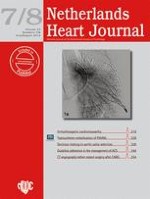Introduction
Epidemiology
Presentation
Diagnosis
I. Global or regional dysfunction and structural alterations | Major: |
- By 2D echo | |
○ Regional RV akinesia, dyskinesia, or aneurysm | |
○ And 1 of the following (end diastole): PLAX RVOT ≥32 mm (correct for body size [PLAX/BSA] ≥19 mm/m2), PSAX ≥36 mm (correct for body size [PSAX/BSA] ≥21 mm/m2, or fractional area change <33 % | |
- By MRI | |
○ Regional RV akinesia or dyskinesia or dyssynchronous RV contraction | |
○ And 1 of the following: ratio of RVEDV to BSA ≥110 mL/m2 (male) or ≥100 mL/m2 (female), or RV ejection fraction ≤40 % | |
- By RV cine-angiography | |
○ Regional RV akinesia, dyskinesia, or aneurysm | |
Minor: | |
- By 2D echo | |
○ Regional RV akinesia or dyskinesia | |
○ And 1 of the following (end diastole): PLAX RVOT ≥29 to <32 mm (correct for body size [PLAX/BSA] ≥16 to <19 mm/m2), PSAX ≥32 to <36 mm (correct for body size [PSAX/BSA] ≥18 to <21 mm/m2, or fractional area change ≤33 to ≤40 % | |
- By MRI | |
○ Regional RV akinesia or dyskinesia or dyssynchronous RV contraction | |
○ And 1 of the following: ratio of RVEDV to BSA ≥100 mL/m2 to <110 mL/m2 (male) or ≥90 mL/m2 to <100 mL/m2 (female), or RV ejection fraction >40 to ≤45 % | |
II. Tissue characterisation of wall | Major: |
- Residual myocytes <60 % by morphometric analysis (or <50 % if estimated), with fibrous replacement of the RV free wall myocardium in ≥1 sample, with or without fatty replacement of tissue on endomyocardial biopsy | |
Minor: | |
- Residual myocytes 60–75 % by morphometric analysis (or 50–65 % if estimated), with fibrous replacement of the RV free wall myocardium in ≥1 sample, with or without fatty replacement of tissue on endomyocardial biopsy | |
III. Repolarisation abnormalities | Major: |
- Inverted T waves in right precordial leads (V1, V2, V3) or beyond in individuals >14 years of age | |
Minor: | |
- Inverted T waves in leads V1 and V2 in individuals >14 years of age or in V4, V5, V6 | |
- Inverted T waves in leads V1, V2, V3 and V4 in individuals >14 years of age in the presence of complete right bundle branch block | |
IV. Depolarisation/conduction abnormalities | Major: |
- Epsilon wave (reproducible low-amplitude signals after the end of the QRS complex to onset of the T wave) in right precordial leads (V1, V2, V3) | |
Minor: | |
- Late potentials by SAECG in ≥1 of 3 parameters in the absence of a QRS duration of ≥110 ms on the standard ECG | |
- Filtered QRS duration (fQRS) ≥114 ms | |
- Duration of terminal QRS <40 uV (low-amplitude signal duration) ≥38 ms | |
- Root-mean-square voltage of terminal 40 ms ≤20 uV | |
- Terminal activation duration ≥55 ms measured from the nadir of the S wave to the end of all depolarisation deflections, including R′, in V1, V2 or V3 in the absence of complete right bundle branch block | |
V. Arrhythmias | Major: |
- Nonsustained or sustained ventricular tachycardia of left bundle branch morphology with superior axis (negative or indeterminate QRS in leads II, III, and aVF and positive in lead aVL) | |
Minor: | |
- Nonsustained or sustained ventricular tachycardia of RVOT configuration, left bundle branch block morphology with inferior axis (positive QRS in II, III and aVF and negative in aVL) or unknown axis | |
- >500 ventricular extrasystoles per 24 h (Holter) | |
VI. Family history | Major: |
- AC confirmed in a first-degree relative who meets current TFC | |
- AC confirmed pathologically at autopsy or surgery in a first-degree relative | |
- Identification of a pathogenic mutation categorised as associated or probably associated with AC in the patient under evaluation | |
Minor: | |
- History of AC in a first-degree relative in whom it is not possible or practical to determine whether the family member meets current TFC | |
- Premature sudden death (<35 years of age) due to suspected AC in a first-degree relative | |
- AC confirmed pathologically or by current TFC in second-degree relative |
